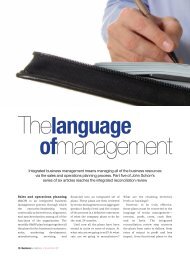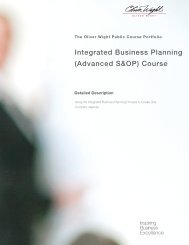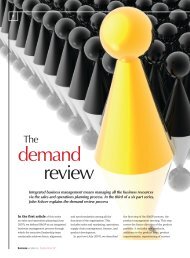CPFR Article - Oliver Wight Americas
CPFR Article - Oliver Wight Americas
CPFR Article - Oliver Wight Americas
Create successful ePaper yourself
Turn your PDF publications into a flip-book with our unique Google optimized e-Paper software.
All Dressed and<br />
Ready to Go<br />
Store-ready demands are reaching a new<br />
level. Here’s how to prepare.<br />
C heck in at the receiving dock of your local grocery store today and<br />
you’re likely to see a completely different picture from what you<br />
saw just 10 years ago. Instead of mixed pallet loads of everything from<br />
soap to cereal, you’re likely to see pallets with very similar products<br />
packed together: A pallet of bread here, another of diapers there.<br />
The idea behind the approach is to make life simpler for the retailer<br />
when it comes to unloading the pallets and lining the store shelves. It’s a<br />
concept that many DCs are finding in increasing demand. Knowing how<br />
to meet these demands in an efficient manner is the path to happier customers<br />
as well as improved numbers.<br />
“The pressure is on to reduce the labor costs at the store level,” says<br />
Lance Reese, technical solutions director at Intelligrated, a material handling<br />
solutions provider. “The theory is that more stores mean more labor<br />
when compared to the DC/store ratio. A reduction on store level cost<br />
should translate into an overall supply chain savings.”<br />
Scott Zickert, at software vendor Red Prairie, agrees. “Store ready<br />
demands have definitely grown over the past few years,” he says. “Companies<br />
are feeling the pressure to put together pallets that are easily<br />
managed at the retail site.”<br />
continued on page 2<br />
A combination of<br />
strategy, proper<br />
software and<br />
equipment can help<br />
achieve the results<br />
retailers want.<br />
Information for Members of the<br />
Warehousing Education and Research Council<br />
November /December 2011<br />
In this issue...<br />
Unique Green Tool 4<br />
DHL recently unveiled its carbon dashboard,<br />
a sign of things to come for shippers.<br />
Collaboration Moves Center Stage 8<br />
It’s “Hot” Once Again<br />
<strong>Article</strong> Index for 2011 11<br />
Fuel Costs:<br />
Higher and Higher<br />
Creative ways to slash fuel bills.<br />
From large to small, there’s not a single company out<br />
there that isn’t feeling the sting of rising fuel costs. No one<br />
wants to pass these costs down to the consumer level, so<br />
everyone is doing whatever they can to avoid that, when<br />
possible. The result is that companies have gotten ever<br />
more creative in finding ways to slash their fuel bills.<br />
Take the Home Depot. The company recently went<br />
through a multi-year supply chain transformation plan. At<br />
the heart of the plan was a move from LTL to truckload service.<br />
To manage this, the company created flow-through<br />
facilities that allow the company to crossdock much of its<br />
merchandise. Instead of having to ship to stores using LTL,<br />
then, the company can ship truckloads.<br />
The savings from such an approach can pay big dividends.<br />
Coffee king Starbucks has also looked at its transportation<br />
strategy as a way to cut costs. The company has<br />
significantly cut its fuel usage—by more than 3 percent—<br />
by reducing the frequency of its deliveries. In addition, it<br />
has reconfigured where some of its DCs are located to get<br />
inventory closer to customers, and is using more intermodal<br />
service.<br />
The methods are as varied as the companies involved,<br />
but one thing is clear: companies must slash their fuel bills<br />
one way or another.<br />
continued on page 6
2<br />
STRATeGY<br />
All Dressed Up and Ready to Go continued from page 1<br />
So what’s a good company to do with these demands?<br />
A combination of strategy, proper software and equipment<br />
can help achieve the results retailers want.<br />
The reality<br />
The trend for store-ready deliveries is so big that<br />
giants like Pepsi beverages Company, based in Somers,<br />
NY, are making changes to ensure an efficient packaging<br />
operation. “In a competitive business environment,<br />
speed and space is always in demand,” says senior vice<br />
president, supply chain strategy, planning and logistics,<br />
Paul Hamilton. “Store-ready shipping is a way to cut the<br />
back-room footprint.<br />
“It also reduces the chance for damage and the costs<br />
related to damaged product, and the labor and time<br />
required for stocking and merchandising. As back-room<br />
footprints shrink, we’ll likely see an increase in storeready<br />
shipping requests.”<br />
Depending on what type of operation you run, your<br />
solutions to store-ready demands will be different. “Grocery<br />
retailers are really pushing the packaging way back<br />
in the DC,’ says Rickert. “They want to get that product off<br />
the truck right away. Clothing retailers might take a bit<br />
more time with their unloading process, so the storeready<br />
packaging doesn’t hold as high a priority for them.”<br />
He sees some commonality, however, in the type of<br />
demands out there. “You might be asked for anything<br />
from preparing pallets in certain ways to breaking those<br />
pallets down at the retailer and putting away inventory,”<br />
he says. “I’ve even seen some retailers ask that pallets<br />
be put together in a way that would enhance the<br />
ergonomics of unloading pallets. Companies want to be<br />
WERCSheet® (USPS # 014998) is published bi-monthly by the<br />
Warehousing Education and Research Council, 1100 Jorie Blvd.,<br />
Ste. 170, Oak Brook, IL 60523-3016.<br />
Phone: (630) 990-0001 Fax: (630) 990-0256<br />
E-mail: wercoffice@werc.org Website: www.werc.org<br />
Annual membership dues are $275, including $80.00 for an<br />
annual subscription to WERCSheet. Periodicals postage rates<br />
paid at Oak Brook, IL (Vol. 34, No. 6)<br />
POSTMASTER: Send address changes to WERCSheet,<br />
1100 Jorie Blvd., Ste. 170, Oak Brook, IL 60523-3016.<br />
WERC assumes no responsibility for unsolicited manuscripts<br />
or other materials submitted for review.<br />
Editor: Rita Coleman<br />
Copyright © 2011 by the Warehousing Education and Research<br />
Council. All rights reserved.<br />
Reproduction in whole or part without written permission is<br />
prohibited. Internet inquiries: www.werc.org.<br />
Writers: Amanda Loudin and Joseph Mazel<br />
/ NOveMbeR–DeCeMbeR 2011<br />
able to track labor costs from before and on through<br />
until the product reaches the shelves.”<br />
Other demands drill all the way down to the carton<br />
and tote level. You might be asked, for instance, to have<br />
end-aisle displays pretty much ready to go when the<br />
trucks reach the stores.<br />
“For most retailers, there’s a push to get store totes<br />
containing items for a department within their stores,”<br />
says Reese. “Others are moving to narrow that requirement<br />
to an aisle within a department. With success in<br />
accomplishing these two levels of service, retailers and<br />
vendors will take the step to shelf targeted store totes.”<br />
Companies that can deliver these demands in the<br />
swiftest and most cost efficient manner will hold the<br />
cards over the competition.<br />
Whatever the case may be, there are added costs<br />
involved and companies need to figure out a way around<br />
them. Often, this can seem like an overwhelming and<br />
expensive road to follow.<br />
What’s needed<br />
being able to handle the demands for store-ready<br />
packaging is usually going to require extra technology<br />
and/or automation. While that adds cost into the<br />
equation, it also can save the costs of either losing<br />
customers, or of using a custom packager to do the job<br />
(see sidebar).<br />
Pepsi beverages Company is handling demands with<br />
a new holistic supply chain solution they’re calling DSD2.<br />
“This process takes a streamlined approach—from sales<br />
and order placement through warehousing and delivery,<br />
and touches all points of the supply chain,” says Hamilton.<br />
“It allows us to provide our customers with the exact<br />
amount of product they need at exactly the right time,<br />
and also offers a way to deliver customized orders based<br />
on geographic preferences or sales peaks. It allows us to<br />
reduce out of stocks and be more exact with forecasts<br />
and order accuracy.”<br />
Reese says that automation of some sort is necessary<br />
to fulfill the retailer demands. “A flexible fulfillment<br />
(order piece picking) system and a method of routing<br />
store totes from pick area to pick area within the DC are<br />
needed,” he says. “A good fulfillment system will also provide<br />
the electronic data required at the store to properly<br />
handle the inbound store totes.”<br />
Zickert says that software solutions play a key role in<br />
also helping determine where labor inefficiencies exist<br />
on both sides of the equation. It can also help establish<br />
rules to help drive the packaging operations.<br />
“It helps to have an order management software<br />
package, but if you don’t have that, we can set up rules
Floor layout<br />
is another<br />
consideration that<br />
can make a big<br />
difference in labor<br />
efficiencies.<br />
within a WMS to match<br />
how retailers want to<br />
receive their pallets with<br />
your inventory and pallet<br />
locations,” Zickert explains.<br />
“There is a wide variety of<br />
ways for us to set up categories<br />
and rules. We can<br />
also establish workforce solutions to help companies<br />
track the orders and their progress.”<br />
Pepsi beverages Company’s priority software helps it<br />
build the perfect orders, says Hamilton. “Then our automated<br />
warehouse retrieval system helps us build the<br />
pallets in one central location,” he explains. “We’re then<br />
able to ‘top the orders off’ at our satellite warehouses.<br />
Since the system is component-based, we have the ability<br />
to mix and match the technology to meet the needs<br />
of the geography.”<br />
Other pieces to the software puzzle might include<br />
slotting software or warehouse control systems to help<br />
set up order sequencing. Having software that can help<br />
load up the pallet in the most efficient manner, especially<br />
when dealing with a variety of sizes and shapes,<br />
can be a big enhancement to operations.<br />
beyond software, companies also must consider<br />
automation.<br />
A simple way to integrate automation into the customized<br />
packaging is to use automatic palletizers that<br />
are fed by conveyor belts. This takes some of the load off<br />
of human labor and is often a faster option.<br />
To really crank it up, some companies use full automation<br />
in the form of AS/RS and/or robots.<br />
Other pieces of the puzzle<br />
being ready to handle store-ready packaging goes<br />
beyond software and automation, however. Floor layout<br />
is another consideration that can make a big difference<br />
in labor efficiencies.<br />
SIDebAR:<br />
Contract Packaging—<br />
A Good Option?<br />
With all the demands on companies to produce<br />
specific packaging for delivery at the store level,<br />
some companies might just want to throw their<br />
hands up in the air and pass the task on to a third<br />
party. And like anything else in life, if there’s a task,<br />
there’s a third party willing to do it—for a price.<br />
enter contract packaging. These companies<br />
receive the products, put them together in the exact<br />
configuration the retailer wants, then ship it back to<br />
the manufacturer’s site for final shipping. These packagers<br />
are pros, so you get a great end product and<br />
save your DC the time and labor involved in performing<br />
the task.<br />
but—it all comes at a high cost, according to<br />
Kane Is Able’s Mike Marlowe, who wrote about the<br />
topic recently. According to Marlowe, using a third<br />
party contract packager adds as much as 30 percent<br />
into your cost line. In this economy, that’s probably<br />
not an expense many companies want to incur.<br />
Instead, Marlowe urges companies to do the task<br />
on their own. If you use a 3PL, see if they do the task.<br />
He lists these benefits of going it alone or with a 3PL<br />
for this task as:<br />
Lower freight costs– All the extra shipping to and<br />
from a contract packager can be as much as 38<br />
percent higher than doing it yourself.<br />
Lower inventory carrying costs– If you use a<br />
contract packager, you can expect to add about<br />
seven days into your cycle.<br />
Reduced labor and equipment– While that<br />
might seem counterintuitive, Marlowe says that by<br />
combining packaging and distribution tasks in the<br />
same building, labor and stock can be deployed<br />
where it’s most needed.<br />
For companies pinching every penny these days,<br />
handling packaging in house, rather than through a<br />
custom packager, makes plenty of sense.<br />
If you have one big customer that makes up most of<br />
your store-ready demands, you might consider allocating<br />
a section of the DC to this customer and setting up<br />
shelving similar to store layout. Yes, this requires some<br />
reengineering and analysis, but the time/labor savings<br />
might make it worthwhile.<br />
Overall slotting is another place you want to consider<br />
to help with the task. Rather than setting up like a<br />
store layout, you could instead keep all similar SKUs in<br />
continued on page 5<br />
/ NOveMbeR–DeCeMbeR 2011 3
4<br />
GOING GReeN<br />
Unique Green Tool<br />
DHL recently unveiled its carbon dashboard,<br />
a sign of things to come for shippers.<br />
E verybody wants to green its supply chain to the<br />
extent that it can economically. Often times it<br />
requires a joint effort between shippers and carriers to<br />
make any kind of meaningful impact. DHL Global Forwarding<br />
recently released its “carbon dashboard” that<br />
makes going green a bit easier for shippers.<br />
According to DHL, up to 50 percent of the carbon<br />
footprint of a product comes from the supply chain. DHL<br />
is betting on the idea that in the future, carbon will<br />
become a global currency. by developing a line of tools<br />
to combat and track carbon emissions, DHL hopes to<br />
make it easier for customers to integrate carbon into<br />
their balance sheets.<br />
The carbon dashboard is essentially an emissions<br />
tracking tool. Shippers working with DHL can use the<br />
tool to receive customized reports on the emissions<br />
released throughout their supply chains.<br />
DHL says that it developed the tool in response to a<br />
study it did in 2009, asking customers<br />
The carbon<br />
dashboard is<br />
essentially an<br />
emissions<br />
tracking tool.<br />
what they wanted out of a green supply<br />
chain. The company says that the study<br />
showed it that business innovation and<br />
customer demand for environmentally<br />
friendly products and services would<br />
drive the logistics industry to become<br />
“carbon efficient.”<br />
based on those findings, DHL Global<br />
Forwarding developed a complete portfolio of green<br />
logistics services. The product line falls into line with<br />
the company’s internal efforts to improve its CO2<br />
emissions and that of its suppliers by 30 percent<br />
by 2020.<br />
How it works<br />
The carbon dashboard is one of those<br />
products and was about a year in the making.<br />
It is an online tool that maps, step-by-step, the<br />
CO2 emissions generated throughout the supply<br />
chain of any one of DHL’s customers. by utilizing the<br />
information delivered from the dashboard, DHL and its<br />
customers can work together to develop individualized<br />
supply chain solutions aimed at reducing the carbon<br />
produced.<br />
/ NOveMbeR–DeCeMbeR 2011<br />
When using the carbon dashboard, customers can<br />
choose from a variety of reports to better understand<br />
the main drivers of carbon emissions from a variety of<br />
transportation modes. The dashboard helps account for<br />
and manages carbon emissions, including third-party<br />
emissions. Customers can tap into detailed CO2 mapping<br />
from a web-based hub.<br />
Taking the data produced from the dashboard a step<br />
further, DHL has developed a way to compare it to other<br />
supply chain parameters. The dashboard uses a standard<br />
calculation approach, allowing customers to compare it<br />
to other factors, such as volume shipped, product density,<br />
and trade lane efficiency. Customers can also “dry<br />
run” various carbon reduction scenarios using real data<br />
and exploring the effectiveness of different optimization<br />
levers.<br />
DHL has a strong track record when it comes to<br />
green initiatives. In 2010 alone, according to the company,<br />
it offset some 82,000 tons of carbon emissions for<br />
its customers. It also shipped over 1.7 billion CO2-neutral<br />
items under its GOGReeN initiative.<br />
While DHL is behind the new dashboard program, it<br />
is just one of many companies that will be introducing<br />
more green products and services<br />
going forward.<br />
For more information on the<br />
carbon dashboard, go to<br />
www.dhl.com.
All Dressed Up and Ready to Go continued from page 3<br />
adjacent locations. Diapers and baby formula, for<br />
instance, are likely to be shelved in the store together or<br />
close by. Keep them near each other in the DC too, to<br />
meet the store-ready demands.<br />
You also must consider quality control if you are<br />
adding another element to your operations. Retailers are<br />
going to come down hard on mis-packaged orders, perhaps<br />
harder even than on a missing order. ensuring your<br />
QC is on top of packaging can help eliminate that risk.<br />
Another potential element to consider is hiring a<br />
packaging professional to help you get set up. These<br />
pros know the best ways to manage packaging demands<br />
and keep customers happy. It may not even need to be a<br />
long-term employee, but a consultant who can help with<br />
the start up of the operation.<br />
Of course, none of these changes come without cost.<br />
Reese recommends taking a long-range approach when<br />
looking to cost justify. “The SKU profile for store ready<br />
orders is determined by the frequency of delivery to each<br />
store and the level for store service,” he says. “To be the<br />
most effective, store orders are most likely to have high<br />
SKU counts and small quantities required of each SKU.<br />
“Store ready is often an automation solution so some<br />
retailers look at the cost of the automaton and compare<br />
WERC Welcomes New Members<br />
Deni Albrecht, Leader of Sustainability, Kenco Logistics Service<br />
Jeff Anderson, Warehouse Manager & Logistics, bunge Oils<br />
Dawn babbe, Administrative Assistant, Kenco Logistics Service<br />
Daniel baker, Transportation Coordinator, bSN Medical, Inc.<br />
Richard L brown, III, Global Logistics & Distribution Manager,<br />
Otterbox<br />
barry burnette, vP - Operations and Logistics,<br />
Tucker Rocky Distributing<br />
Molloy T. Dial, Jr., Director of Logistics & Transportation,<br />
Friedrich Air Conditioning<br />
Angshuman Doraswamy, Head - Operations,<br />
Weavings Manpower Solutions PvT LTD<br />
Norman J Dunn, Director, Tropical Shipping<br />
Stan Durham, Director of Operations, GSI Commerce<br />
Ryan J eberle, Distribution Coordinator, Johnsonville Sausage<br />
Jason esser, GM, Kenco Logistics Service<br />
Terry Fillner, Quality Systems Manager,<br />
Steven L Fuller, MbA, Director of Operations, brightstar Australia<br />
Kristyn Gaboury, Inventory Supervisor, Kenco Logistics Service<br />
Fred Gants, Partner, Quarles & brady LLP<br />
Mike Geesey, Sr. Consultant Operations Analytics, CardinalHealth<br />
Matthew J Goordman, Director of Warehousing, Winebow, Inc.<br />
Alfred D Herrera, branch Operations Manager, victaulic<br />
Kevin Humphrey, Sales Director, PINC Solutions<br />
Carmen M Jackson, Customer Operations Manager, Pitney bowes<br />
it to the labor savings over a short period of time. The<br />
investment in the automation should be considered over<br />
a longer period of time.”<br />
Pepsi beverages Company’s Hamilton expects that<br />
the changes the company has made will be well worth it.<br />
“A new approach takes time, and our DSD2 solution has<br />
been years in the making,” he says. “While it delivers tremendous<br />
value in the long term, it also requires<br />
significant upfront capital. We’ve been able to use our<br />
Tampa location as a pilot and learn from our opportunities<br />
there.”<br />
He recommends that other manufacturers keen to<br />
provide packaging solutions to customers take a holistic<br />
approach. “Many companies look at business functions<br />
as stand-alone silos,” she says. “Sales, warehousing, and<br />
go-to-market tend to be viewed as separate entities. Taking<br />
a broader, more collaborative view is key, because<br />
while it might mean that in the short term one functional<br />
team might make some ‘trade-off’ for the collective good<br />
in terms of capital or investments, the broader solution<br />
ultimately benefits the entire organization.”<br />
2011 © Copyright, WERC. All rights reserved.<br />
Lance Reese, Intelligrated, www.intelligrated.com<br />
Scott Zickert, Red Prairie, www.redprairie.com<br />
Paul Hamilton, Pepsi Beverages Company, www.pepsi.com<br />
John W. Jacobi, DC Manager, Milbank Manufacturing Co<br />
Hisham Khaki, Director Logistics engineering, Kenco Logistics Service<br />
brian Lashley, Director, Operations, GeNCO ATC<br />
Jorge Martinez, Director of Distribution, James Avery<br />
edward A McGeehan, President, Sindall Warehouse and Distribution<br />
David C McMichael, General Manager, Schenker Logistics<br />
Kevin Meagle, Operations Manager, eGS electrical Group<br />
Paul M Moreno, Warehouse Manager, boston Gear<br />
Mark Olah, Operations Supervisor, Kenco Logistics Service<br />
Glenn Packer, Operations Manager, Kenco Logistics Service<br />
vince Pici, Manufacturing Services Manager,<br />
McKee Foods Corporation<br />
Michael Pickens, Director of Operations, Schneider Port Logistics<br />
Scott Reinhart, GM, Kenco Logistics Service<br />
Allen M Rudis, Team Leader, Signature breads, Inc.<br />
bright C Samuel, Contract Manager, Metalworth Resources LTD<br />
Tim Schueler, Sr. Quality engineer, Americold<br />
Lance Smith, Transportation Operations Manager,<br />
Kenco Logistics Service<br />
Jon Stiffler, vP of Warehousing and Distribution, bay valley Foods<br />
James P Sullivan, Pricing Manager<br />
Kevin Wicks, vP of business Development, Daryl Flood Logistics<br />
Andrew T. Williams, business Development Manager,<br />
vanderlande Industries<br />
Michael Wright, vP, Midwest Global Distribution<br />
/ NOveMbeR–DeCeMbeR 2011 5
6<br />
TRANSPORTATION<br />
The methods<br />
are as varied as<br />
the companies<br />
involved, but one<br />
thing is clear:<br />
companies must<br />
slash their fuel<br />
bills one way or<br />
another.<br />
Fuel Costs: Higher and Higher continued from page 1<br />
Pooling resources<br />
One approach to cutting fuel costs that is working<br />
for some shippers is transportation pooling. Stage Stores,<br />
based in Houston, has taken the bull by the horn in this<br />
accord. With over 800 stores that include bealls, Goody’s<br />
and Peebles, and 30 new stores on the way, fuel costs<br />
have a big impact on the company’s bottom line. Stage<br />
Stores recently decided that it couldn’t continue with the<br />
way things were going.<br />
“The cost of fuel is a big deal for us,” says Gough<br />
Grubbs, senior vice president of logistics and distribution.<br />
“It’s pushed us to do things we<br />
should have done in the past.”<br />
Grubbs estimates that since 2010,<br />
fuel costs have risen 28 percent. “Those<br />
are big bites to combat,” he says. “Many<br />
retailers, like Macy’s and Penney’s, are<br />
doing some of the same things we are.”<br />
At the heart of the changes Stage<br />
has made is a pooling program with<br />
other retailers operating in the similar<br />
locations. The company has three<br />
DCs—one each in Texas, virginia, and<br />
Ohio—and works with other retailers to<br />
utilize the DCs for pooling.<br />
“We have small stores and deal with small numbers<br />
of cartons,” explains Grubbs. “We want product going<br />
into our stores every day. If we couldn’t fill a truck, we figured<br />
other small store retailers couldn’t either.”<br />
After talking with their carriers about what could be<br />
done to improve the costliness of the situation, Stage<br />
Stores began looking for retailers that might want to<br />
share space on trucks. “Our carriers helped us find the<br />
partners,” says Grubbs. “Now we work with three other<br />
retailers to pool space.”<br />
The program works by having Stage’s partners ship<br />
their small parcels into Stage’s DCs, where Stage crossdocks<br />
and loads them onto trucks. Stage adds its own<br />
products to the mix and the trucks fill up, much quicker<br />
than the small loads Stage was sending onto the road<br />
before.<br />
“As the program grows, we’ll be able to grow our<br />
network of retailers who want to be involved,” says<br />
Grubbs. “So we not only get a better frequency of trailer<br />
releases out, but we get our carrier to pick up inbound<br />
from some of our vendors at lower rates as well. It gets<br />
you out of the bidding war for drivers.”<br />
Additional savings came in the form of negotiated<br />
inbound rates. “We’ve got those rates lower than they’d<br />
typically be,” says Grubbs, “because the trucks are already<br />
out there.”<br />
/ NOveMbeR–DeCeMbeR 2011<br />
To coordinate the program,<br />
Stage worked with its<br />
carrier on software. “We<br />
have a third party who does<br />
the manifesting,” explains<br />
Grubbs. “Now it’s universal<br />
and we sort by zip code in<br />
the barcode.”<br />
While the offset to fuel<br />
costs is important, Grubbs<br />
“The more<br />
partners you get<br />
involved, the<br />
lower the costs<br />
and the more<br />
frequent the<br />
deliveries.”<br />
Gough Grubbs<br />
points to the additional benefit of more timely product<br />
release as key to the company’s continued success. “In<br />
2009, when the economy took a hit, we went to our carrier<br />
and said ‘if we don’t go every day to the out-of-way<br />
stores, can you reduce our rates?’ and the answer was<br />
yes,” he explains. “Now with the additional volume on the<br />
trucks, we can get shipments out more timely.”<br />
Grubbs recommends that more retailers consider<br />
pooling programs. “Many companies don’t even know<br />
what percent of their volume goes on truckload versus<br />
LTL, etc.,” he says. “but there’s such a big variance in costs<br />
that you need to be on top of it.”<br />
More = better<br />
The company has looked at several other ways to<br />
reduce costs. One involved buyers. Grubbs says that<br />
getting buyers to coordinate can pay off. “We have so<br />
many different buyers and they didn’t collaborate,”<br />
he explains. “So now we are coordinating with their<br />
pickups.”<br />
Last year Stage Stores also got deep into its packaging<br />
practices to see where they could find savings.<br />
“We’d find cartons with only a couple of items in them,”<br />
he explains. “We can’t afford to ship air. We worked with<br />
the vendors to reduce the carton use to a fraction of<br />
what it was.”<br />
The huge benefit from all of these actions is that<br />
Stage is managing to avoid passing along rising fuel<br />
costs to customers. “Costs go up and you have margins<br />
you need to hit,” Grubs says. “but we’ve tried to keep the<br />
costs under control for our customers.”<br />
As Stage Stores continues to reap the benefits from<br />
its efforts, Grubbs continues to get requests from other<br />
retailers to get involved. “There are a lot of small retailers<br />
out there and small parcel rates keep going up,” he<br />
explains. “You kind of get forced into a pooling program<br />
if you want to keep costs down.”<br />
When a pooling program first gets under way, you’re<br />
not going to get daily deliveries, says Grubbs. “but as the<br />
program grows, that changes and you get more frequent<br />
deliveries,” he says. “The more partners you get involved,
the lower the costs and the more frequent the deliveries.”<br />
He points out that getting involved in a pooling program<br />
requires a definite leap of faith. “You can’t go it<br />
alone,” he says. “You need a carrier who can participate<br />
and you need partners will to take a risk. You have to<br />
learn to trust your partners in this. When you see the<br />
benefits, you know it’s worth it.”<br />
Rethinking relationships<br />
Retailers and shippers aren’t the only ones feeling<br />
the pinch from the fuel costs. Trucking companies are<br />
also hard hit. Many smaller companies have faced bankruptcy<br />
over the past couple of years. even large<br />
companies—those with as many as 1,000 units—are disappearing<br />
in some cases.<br />
This has forced carriers into rethinking the way they<br />
operate. This means changes for shippers too, who must<br />
readjust to the new way of business with their carriers.<br />
With fewer trucks on the roads thanks to bankruptcy,<br />
shippers may soon face a capacity shortage. Taking steps<br />
now to avoid pain as fewer trucks become available will<br />
help ease the pain.<br />
Like Stage Stores did, consider working with your<br />
carriers in different and unique ways. by working<br />
together, you can come up with solutions you might not<br />
have thought of on your own. Also negotiate contracts<br />
to ensure you do not have to absorb all the costs on the<br />
shipping end.<br />
Do like Starbucks did and think about how to move<br />
DCs closer to the customer. This cuts down on miles and<br />
thus minimizes the fuel costs incurred. Or if you’re a manufacturer,<br />
consider consolidating manufacturing and<br />
warehousing.<br />
When working with carriers, talk to them about their<br />
typical freight flows. If you can mesh with their schedules<br />
and flows, you can likely cut down on costs. Give you carrier<br />
a chance to offer up options.<br />
Finally, think outside of the carrier mode. Rail, while<br />
slower, is a cheaper option. Weigh the pros and cons of<br />
adding a day or two to your supply chain. The savings<br />
may prove worthwhile.<br />
In the end, it’s often the most creative companies<br />
that weather the storms the best. being flexible and<br />
open to new ideas just might be the ticket to minimize<br />
fuel costs and see you through to the other side of the<br />
recession.<br />
Copyright © 2011, WERC. All rights reserved.<br />
Gough Grubbs, Stage Stores, www.stagestores.com<br />
SIDebAR:<br />
What Government is Doing to Help<br />
There’s no question that the rising fuel costs have a negative<br />
impact on the economy. As it gets harder and harder for companies<br />
to meet their gas bills, the costs get passed along to customers and<br />
ultimately, the consumer. And thus the vicious cycle continues.<br />
Recognizing this, government has made efforts to help ease the<br />
pain for the overall economy by developing a set of standards aimed<br />
at improving fuel efficiencies in heavy duty trucks and buses.<br />
Released in August, the new standards were a joint effort between<br />
DOT, the ePA and several industry stakeholders, including transportation<br />
and distribution companies.<br />
The comprehensive program will focus on trucks and buses built<br />
from 2014 to 2018 and is expected to reduce oil consumption by 530<br />
million barrels. It is also expected to reduce greenhouse gas pollution<br />
by approximately 270 metric tons.<br />
vehicles included in the standards fall into three categories: combination<br />
tractors, heavy-duty pickup trucks and vans; and vocational<br />
vehicles like transit buses and refuse trucks. There are specific targets<br />
within each category depending on the design and purpose of the<br />
vehicle. each subcategory will have its own set of achievable goals for<br />
each year.<br />
According to the government, the program should yield an estimated<br />
$50 billion in net benefits over the life of model year 2014 to<br />
2018 vehicles, and to resulting significant long-term savings for vehicle<br />
owners and operators. A semi truck, for instance, should be able to<br />
pay for the technology upgrades in under a year and realize a net savings<br />
of $73,000 through reduced fuel costs over the truck’s lifetime.<br />
Some semis will be required to achieve up to approximately 20<br />
percent reduction in fuel consumption and greenhouse gas emissions<br />
by model year 2018, saving up to four gallons of fuel for every 100<br />
miles traveled.<br />
For vocational vehicles such as delivery trucks, the requirement<br />
will reduce fuel consumption and greenhouse gas emissions by<br />
approximately 10 percent by model year 2018.<br />
The American Trucking Associations support the new standards<br />
and say that they fit well into its overall plans to improve truck fuel<br />
efficiencies. The organization added several other suggestions to<br />
enhance fuel efficiency, including:<br />
A national speed limit of 65<br />
Rules that would allow trucks to be electronically governed<br />
at that speed<br />
Efforts to reduce congestions, which leads to increased idling<br />
and wasted fuel<br />
Incentives for technology reduces idling while trucks are<br />
off the road<br />
Continuation of the EPA SmartWay program<br />
Reforms of federal truck size and weight limits to allow the<br />
industry to operate its most productive and efficient vehicles.<br />
/ SNOveMbeR–DeCeMbeR 2011 7
8<br />
ReLATIONSHIPS<br />
Collaboration Moves Center Stage–<br />
It’s “Hot” Once Again<br />
Existing practices, newer techniques actively promote<br />
collaboration as their core principle.<br />
C ollaboration is back, stronger than ever, prompting<br />
the question: Did it ever really go away? With<br />
the re-emergence of collaboration as an acknowledged<br />
and accepted business practice, and the emphasis<br />
on terms such as “we,” “trust,” and “sharing,” several<br />
authorities closely associated with collaborative initiatives<br />
were asked for their insights. Their comments:<br />
“As supply chains get longer, more fragile and more<br />
complex, the idea of creating long-term collaborative<br />
partnerships is gaining more traction. but it’s one<br />
thing for companies to be aware of the need to<br />
collaborate, to assert they are collaborative, and quite<br />
another to have truly collaborative people and<br />
processes in place.” Kate Vitasek, founder, Supply<br />
Chain visions, bellevue, Wash., and faculty member,<br />
University of Tennessee’s Center for executive<br />
education.<br />
“I don’t think collaboration ever went away, but<br />
it’s much more acceptable now. Our industry and<br />
business in general has evolved in a way that<br />
companies can now focus on the benefits of a<br />
mutually beneficial collaborative partnership.”<br />
Chris Kane, chief customer strategy officer,<br />
Kane Is Able, Scranton, Pa.<br />
“Collaboration continues to advance while the<br />
hype-cycle peaked and waned over time. Companies<br />
never stopped increasing information-sharing and<br />
developing collaborative scorecards to manage and<br />
monitor performance.” Larry Smith, senior vice<br />
president, planning and replenishment, West Marine,<br />
Watsonville, Cal., and co-chair, The vICS <strong>CPFR</strong><br />
Committee Advisory Team.<br />
“The need for collaboration never went away. It is<br />
simply that as companies migrate more towards<br />
better internal integrated collaboration they see a<br />
need and benefits of collaborating externally with<br />
trading partners.” Ron Ireland, principal, <strong>Oliver</strong> <strong>Wight</strong><br />
<strong>Americas</strong>, New London, NH.<br />
/ NOveMbeR–DeCeMbeR 2011<br />
<strong>CPFR</strong> is about collaboration<br />
Fundamentally, the aim of Collaborative Planning,<br />
Forecasting and Replenishment (<strong>CPFR</strong>) is to convert the<br />
supply chain from a disjointed, ineffective and inefficient<br />
“push” system to a coordinated “pull” system based upon<br />
end customer demand. “vICS <strong>CPFR</strong> is defined as a business<br />
practice that combines the intelligence of multiple<br />
trading partners in the planning and fulfillment of customer<br />
demand,” explains Smith. “<strong>CPFR</strong> links sales and<br />
marketing best practices, such as category management,<br />
to supply chain planning and execution processes to<br />
increase availability while reducing inventory, transportation<br />
and logistics costs.”<br />
The vICS <strong>CPFR</strong> committee re-launched the brand in<br />
2003 and 2004, replacing a “seemingly rigid nine step<br />
model” with a four quadrant process model that was<br />
accompanied by four guidelines exploring emerging and<br />
broadly followed approaches to Store Level Collaboration,<br />
DC Level Collaboration, event Forecast Collaboration,<br />
and Assortment Planning Collaboration in Apparel and<br />
Footwear. Last year the committee published a significant<br />
guideline aligning <strong>CPFR</strong> and S&OP (“Linking <strong>CPFR</strong> and<br />
S&OP: A Roadmap to Integrated business Planning”), and<br />
is currently finalizing a guideline providing best practice<br />
recommendations to industry participants on managing<br />
retailer supplier schedules (or order forecasts).<br />
“Our emphasis on collaboration is total because we<br />
believe and know from our practical business experiences<br />
that innovating together in a connected supply<br />
chain will increase the potential benefits for all supply<br />
chain participants,” maintains Smith. “For a <strong>CPFR</strong> program<br />
to be successful, the lead trading partner needs to<br />
engage its trading partner organization at multiple levels<br />
as well as across multiple disciplines.”<br />
Logistics, distribution and <strong>CPFR</strong><br />
Logistics and distribution are key parts of the collaborative<br />
teams in any <strong>CPFR</strong> engagement. “After all, the<br />
essential handoff in the supply chain is company-to-company<br />
shipping and receiving,” says Smith. “Collaboration<br />
metrics include on-time and complete shipping as well as<br />
freight presentation and accuracy.”<br />
Logistics and distribution must participate in capacity
planning and lines and dollar forecasts for both inbound<br />
and outbound shipments. The <strong>CPFR</strong> inputs to this planning<br />
process derive from a robust forward forecast.<br />
Without such a forecast, the logistics and distribution<br />
team is limited to planning based on prior years or<br />
trending current activity levels, neither of which is likely<br />
to be as predictive as the <strong>CPFR</strong> forecast for key logistics<br />
and distribution activities,” explains Smith.<br />
“The teams will gain a greater understanding of the<br />
factors that may increase volume variability, as well as<br />
how to manage variability,” he notes. “being a full partner<br />
in the process and fully informed, the logistics and distribution<br />
team will be able to exercise their command of<br />
effective processes to lower costs and achieve higher<br />
service levels.”<br />
Collaboration key to IBP/S&OP<br />
Integrated business Planning/Sales & Operations<br />
Planning (IbP/S&OP) is an executive management process<br />
for operating and managing an entire business or<br />
enterprise. IbP/S&OP initially is used for internal collaboration<br />
and the processes then become the foundation<br />
for external collaborative practices such as <strong>CPFR</strong>. “All of<br />
the functions within a company keep quantitative and<br />
qualitative information, plans, and actions aligned and<br />
synchronized on a continuous basis,” says George Palmatier,<br />
principal, <strong>Oliver</strong> <strong>Wight</strong> <strong>Americas</strong>. “Similarly,<br />
customers and suppliers are aligned and synchronized<br />
when IbP/S&OP is extended beyond the internal functions<br />
of a company.”<br />
“To establish collaboration as the norm requires<br />
strong leadership from the chief executive or the personin-charge,”<br />
says Colleen “Coco” Crum, <strong>Oliver</strong> <strong>Wight</strong><br />
<strong>Americas</strong> principal. “As an IbP/S&OP process is implemented,<br />
you witness collaboration at the executive<br />
management level and middle management level.”<br />
The focus shifts from how to optimize an individual function<br />
to what do we all need to be doing to ensure that we<br />
are satisfying customers’ expectations and meeting our<br />
enterprise’s business and strategic goals, she explains.<br />
being collaborative and operating IbP/S&OP successfully<br />
takes practice,” maintains Crum. “Companies should<br />
not spend a year or longer trying to design the perfect<br />
IbP/S&OP process. Less than perfect processes bring substantive<br />
operational and financial improvements to<br />
companies.”<br />
To get quick wins, implement the process as rapidly as<br />
possible and then use a continuous improvement<br />
approach to improve the process every cycle is the advice.<br />
Next frontier for IBF/S&OP<br />
Transportation and logistics is the next frontier for<br />
IbP/S&OP. For a transportation and logistics company,<br />
begin to establish IbP/S&OP for the business, and then<br />
once it is working well internally, move on to collaborate<br />
with external partners. For a transportation and logistics<br />
organization within a company, the objective shifts to<br />
having this organization gain a seat at the table in the<br />
company’s IbP/S&OP process. If the company does not<br />
have an existing IbP/S&OP process,<br />
Crum suggests the transportation<br />
and logistics organization move<br />
ahead with the process and begin to<br />
influence the value gained from better<br />
integrated planning and<br />
collaboration.<br />
Vested Outsourcing<br />
vested Outsourcing, an outcomebased<br />
hybrid business model<br />
developed by University of Tennessee<br />
researchers through extensive field<br />
work, starts from the premise that<br />
there is a better way to form and<br />
manage the outsourcing relationship between company<br />
and service provider. “The concept is based on collaboration,<br />
communication, innovation, and trust, where all of<br />
the parties have a vested interest in successfully achieving<br />
clearly defined outcomes,” explains vitasek.<br />
“The vested model employs five rules designed to<br />
transform the outsource partnership and encourage<br />
innovation, moving it beyond the old and inadequate<br />
transaction-based model that is based on lowest possible<br />
labor and transportation costs while eliminating the common<br />
ailments that can hinder or derail the outsource<br />
relationship,” according to vitasek, who authored two<br />
compelling books on the topic (“vested Outsourcing: Five<br />
Rules That Will Transform Outsourcing,” and “The vested<br />
Outsourcing Manual”). The five rules are linked to ten elements<br />
designed to take practitioners through the vested<br />
Outsourcing implementation in a coherent, coordinated<br />
and systematic way from identifying the business, sharing<br />
the vision, stating intentions, to managing and<br />
governing the enterprise.<br />
“Collaboration is intrinsic and essential to a successful<br />
vested Outsourcing partnership,” maintains vitasek.<br />
There is no way to construct, implement and manage a<br />
The vested model<br />
employs five rules<br />
designed to<br />
transform the<br />
outsource<br />
partnership and<br />
encourage<br />
innovation…<br />
Kate Vitasek<br />
continued on page 10<br />
/ NOveMbeR–DeCeMbeR 2011 9
10<br />
“The flow of<br />
information among<br />
manufacturers,<br />
3PLs, and retailers<br />
is what keeps the<br />
entire process<br />
running…”<br />
Chris Kane<br />
/ NOveMbeR–DeCeMbeR 2011<br />
Collaboration Moves Center Stage continued from page 9<br />
vested agreement without continuous<br />
and real collaboration. It would be<br />
impossible to craft a realistic and effective<br />
shared vision and Statement of<br />
Intent, for example, without a true collaborative<br />
mindset.” She also coined<br />
the phrase: “What’s in it for We,” with<br />
the emphasis on “We.”<br />
both parties must enter the vested<br />
relationship with a firm idea of what they want to<br />
accomplish and a real desire to work together—to<br />
collaborate— to reach their goals, she insists. vitasek<br />
advises: Top-level executive buy-in is essential along<br />
with a clear understanding of each party’s capabilities,<br />
cultural and administrative guardrails.<br />
“The vested approach is a new way of thinking about<br />
the business relationship and requires a level of trust<br />
among companies, both internally and externally, that<br />
perhaps they have never considered or experienced,”<br />
she notes.<br />
Collaborative Distribution<br />
Collaborative Distribution is more than a simple<br />
freight consolidation program, argues Kane. “It’s a new<br />
way of doing business that embraces the dynamic relationships<br />
that are necessary among manufacturers, 3PLs,<br />
and retailers to create a continuous flow of information<br />
and product in a consumer-driven market.”<br />
In Collaborative Distribution manufacturers warehouse<br />
their goods with a view of consolidating deliveries<br />
with other manufacturers’ goods going to the same final<br />
destination. Deliveries by different suppliers on the same<br />
routes are consolidated into full truckloads, and 3PLs act<br />
as traffic cops to make it all work smoothly (provide<br />
simplify billing, flat-rates and per-pallet charges, etc.).<br />
The benefits are “staggering,” according to Kane:<br />
Reduced transportation, which is the largest cost center<br />
in the supply chain for manufacturers; less frequent, consolidated<br />
orders for retailers; and reduced emissions and<br />
fuel usage due to fewer trucks on the road for everyone.<br />
“Collaboration is the heart of the process,” he insists.<br />
“The flow of information among manufacturers, 3PLs,<br />
and retailers is what keeps the entire process running,<br />
and I think it’s exactly what has kept many companies<br />
from exploring Collaborative Distribution,” Kane maintains.<br />
“Advanced in technology and successful<br />
partnerships have proven that sharing information can<br />
be a very lucrative endeavor.”<br />
Creating an environment of trust is absolutely essential.<br />
“One of the best ways to establish that environment<br />
is to create a common set of goals and performance indicators,”<br />
he explains. Over time, these expectations need<br />
to be monitored, met (or exceeded), discussed and<br />
revised on a regular basis among all of the contributors.<br />
“Through this process, collaboration begins to foster<br />
innovation allowing the whole enterprise to become<br />
greater than the sum of its parts,” maintains Kane.<br />
“Although Collaborative Distribution is a process, I<br />
believe it’s also a state of mind. It’s about sharing information<br />
and using that insight to make an operation<br />
more efficient, more cost effective, or just plain better.”<br />
Lasting insights<br />
“Collaborative innovation driving value is the essence<br />
of the expanding opportunity available to collaborative<br />
value chains,” states Smith. “Collaborative organizations<br />
understand that they are not competing with supply<br />
chain partners, they are competing as supply chains.”<br />
<strong>Oliver</strong> <strong>Wight</strong>’s Crum observes: “We foresee that as<br />
companies gain competency in collaborating internally<br />
and externally, collaboration will become a standard<br />
practice, rather than a best practice.”<br />
Copyright © 2011, WERC. All rights reserved.<br />
Chris Kane, Kane Is Able, www.kaneisable.com<br />
Kate Vitasek, Supply Chain Visions, www.scvisions.com<br />
Larry Smith, West Marine, www.westmarine.com<br />
Ron Ireland, <strong>Oliver</strong> <strong>Wight</strong> <strong>Americas</strong>,<br />
www.oliverwright-americas.com<br />
The VICS <strong>CPFR</strong> Committee, www.vics.org<br />
PS Form 3526: Statement of Ownership, Management, and Circulation<br />
Publication title: WERCsheet; publication number 014-998; filing date 9-28-11; issue frequency: bi-monthly; number of<br />
issues published annually: 6; annual subscription price: $80.00. Name and address of publisher: Warehousing education<br />
and Research Council, 1100 Jorie blvd., Ste. 170, Oak brook, IL 60523-4413; editor: Rita Coleman. Owner: Warehousing<br />
education and Research Council. Tax Status: The purpose, function, and nonprofit status of this organization and the<br />
exempt status for federal income tax purposes has not changed during preceding 12 months.<br />
extent and Nature of Circulation: average no. copies each issue during preceding 12 months; total: 1800; paid or requested<br />
mail distribution: 1,627; free or nominal rate distribution: 115; total distribution: 1742; not distributed: 58; percent<br />
paid and/or requested circulation: 90.0. No. copies of single issue published nearest to filing date; total number of copies:<br />
1,800; total paid and/or requested distribution: 1,641; free or nominal rate distribution: 113; not distributed: 46; total<br />
distribution: 1,800; percent paid and/or requested circulation: 94%.
<strong>Article</strong>s are presented chronologically by topic.<br />
EQUIPMENT<br />
Issue PAge<br />
Not Your Father’s Scanner May/June 10<br />
A new crop of barcode scanners is making its mark in the DC.<br />
FACILITIES<br />
Distribution Network (Re)Design…When?...Now! March/April 8<br />
Identifying and deploying network improvements can bring<br />
competitive advantage in service, costs.<br />
GOING GREEN<br />
Government Goes Green May/June 1<br />
A new initiative aims to green the government’s supply chain.<br />
Green Logistics July/August 11<br />
Nortel Greens its Shipping<br />
Unique Green Tool Nov/Dec 4<br />
DHL recently unveiled its carbon dashboard, a sign of<br />
things to come for shippers.<br />
METRICS<br />
No Progress Jan/Feb 8<br />
2010 Logistics Cost and Service Report<br />
Not so Fast Sept/ Oct 8<br />
The State of Logistics report reveals an industry working hard to make<br />
headway in a slow economy.<br />
PROCESSES<br />
Big Toys for the DC March/April 6<br />
Automated case picking holds plenty of promise for improving<br />
productivity and slashing costs.<br />
PEOPLE<br />
Work = Fun? May/June 8<br />
At Threadless, that’s a definite yes. How your DC can learn<br />
from this t-shirt company’s unique approach to the work day.<br />
Permanent Solutions to Temporary Issues Sept/ Oct 1<br />
Handled correctly, you can maximize your efficiencies with<br />
a top-notch temporary workforce.<br />
RELATIONSHIP<br />
2011 WERCSheet Index of <strong>Article</strong>s<br />
Driving Towards Tighter Shipper-Carrier Bonds Sept/ Oct 8<br />
Six industry experts share their insights and experiences on how to<br />
encourage and solidify relationships.<br />
Collaboration Moves Center Stage– Nov/Dec 8<br />
It’s “Hot” Once Again<br />
STRATEGIES<br />
Issue PAge<br />
Consumer Commodities Contained Jan/Feb 6<br />
Aggressive proactive initiatives changing culture and<br />
returning results for OHL.<br />
Ergonomics Today Jan/Feb 1<br />
Companies are recognizing that good ergonomics equals<br />
good business sense.<br />
Risks Impacting Supply Chains a Growing Concern May/June 1<br />
Managing Inventory in Tough Times July/August 8<br />
Never an easy job, managing inventory gets even more<br />
complex when the economy is slow.<br />
All Dressed and Ready to Go Nov/Dec 1<br />
Store-ready demands are reaching a new level.<br />
Here’s how to prepare.<br />
SYSTEMS<br />
RFID 2011: Rebound Continues Jan/Feb 1<br />
Compound annual growth rates of up to 40% forecast<br />
for RFID markets through 2015.<br />
TRANSPORTATION<br />
Drivers Hours of Service Law March/April 4<br />
Déjà vu all over again.<br />
The New Big Dig March/April 1<br />
What the Panama Canal expansion project means<br />
for U.S. logistics.<br />
Mexican Trucks on U.S. Roads May/June 4<br />
After years of debate, it appears that the debut of Mexican<br />
trucks on U.S. roads is finally going to happen.<br />
No Easy Answers Sept/ Oct 4<br />
One portion of the highway reauthorization bill is leading to<br />
major headaches for those at the negotiating table.<br />
Fuel Costs: Higher and Higher Nov/Dec 1<br />
Creative ways to slash fuel bills.<br />
WERC<br />
Statement of Ownership Nov/Dec 10<br />
Official Notice Board of Directors Slate March/April 11<br />
WERC’s 34th Annual Conference Coverage July/August 1<br />
/ NOveMbeR–DeCeMbeR 2011 11
The WERC Conference offers a COMPLETE<br />
package for the Logistics practitioner.<br />
May 6–7<br />
Atlanta Marriott Marquis<br />
ATLAnTA, GA<br />
Logistics<br />
Pros:<br />
Register Today!<br />
Six Reasons to Attend<br />
1.<br />
2.<br />
3.<br />
4.<br />
5.<br />
6.<br />
70% of the program is updated<br />
or new<br />
Practical application is proven<br />
NetWERCing<br />
Convenience of one location<br />
Cost Effective<br />
WERC offers a Guarantee<br />
OUR GUARAnTEE<br />
WERC stands behind the quality of our conference<br />
program; therefore, if conference does not deliver a quality<br />
educational and networking event, we want to hear from<br />
you. WERC will provide you with a credit certificate toward<br />
any future WERC national educational program, or refund<br />
your money.<br />
Everything you need to know is at<br />
www.werc.org<br />
PeRIODICALS<br />
2012 SPONSORS

















